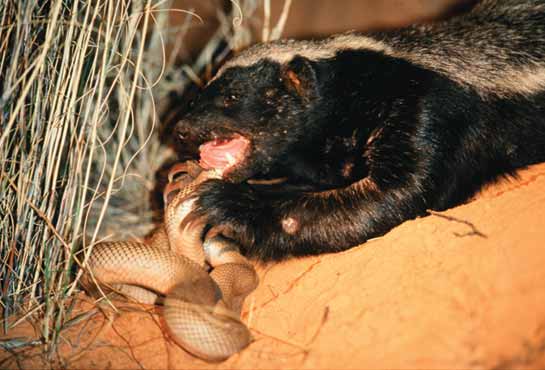The honey badger (also known as the ratel) is a creature that has gained great fame for its fearless and relentless nature. One of the amazing characteristics of the honey badger is its propensity to devour poisonous prey including many of Africa’s most deadly snakes, scorpions and bees.

Honey badgers forage over large areas using their outstanding sense of smell to locate prey in their underground burrows. The honey badger is known to also blow a strong burst of air into burrows and then listen for movement. Once prey is located the badger is a digging machine considered second in ability only to the aardvark among African mammals. Stocky muscular build, exceptionally long front claws (inch and a half in length), and small ears that can be squeezed close are adaptations that allow for fast excavation. The honey badger is versatile though and can race up through trees in pursuit of snakes or to raid raptor nests as well, in fact a study in the Kalahari by Keith and Colleen Begg found that the ratel preyed on over 60 different species.
Snakes feature prominently as a large prey item that can provide most of the daily food requirement in one meal and the honey badger is not deterred by those that are considered to contain deadly venom. Cobras, black mambas and especially puff adders are regularly on the menu. The honey badger will attack at the head to make the kill and then consume it rather quickly from the head to tail (see amazing video at nationalgeographic.com/magazine/0409). Even though the honey badger is a master snake killer sometimes the snake gets in a hit that should be deadly. In one of the continuing mysteries of the honey badger they have a certain immunity to venom that is not fully understood. Their very thick, rubbery, and loose skin probably is a help and they have been observed being bitten with no visible effects. Other times it appears very serious and the honey badger will curl up into a deep slumber but in two to three hours the badger will pop back up and consume the dead snake before trotting off. If the physiology behind this immunity could ever be deciphered it could provide a miracle drug for humans following dire snake bites.
Raiding bee hives creates a different type of problem due to the swarming nature of African honey bees. As the name honey badger suggests this species seems to consider bee brood a delicacy and they will go out of their way to raid a hive. A bird, the honey guide, is thought to find badgers and lead them to hives where the bird is able to consume the bees wax once the badger opens the nest. The same adaptions for digging — long claws and closeable ears work well for shredding open hives and it is believed the badger can withstand hundreds of stings without damage. Another fascinating adaptation is reports that honey badgers fumigate the bees by using powerful anal glands, it is even rumored that the badger will do a handstand so it can smear a secretion on the hive and by swirling its tail it can send the odor in to suffocate the bees, the equivalent of humans smoking them out. This could be a myth but many beekeepers report numerous dead bees and potent smells following a raid by the honey badger suggesting this method does indeed occur. In this case the remarkable honey badger truly fights poison with its own version of toxic fumes.
Something to Think About:
1. Venomus snake bites can kill 200 pound humans within hours without treatment, yet female honey badgers can survive bites and weigh only 15 lbs.
2. Despite the fact that honey badgers range throughout sub-Saharan Africa all the way north into India very little research has been conducted and virtually all the definitive knowledge has come recently from Colleen and Keith Begg’s study in the Kalahari beginning in 2000.
